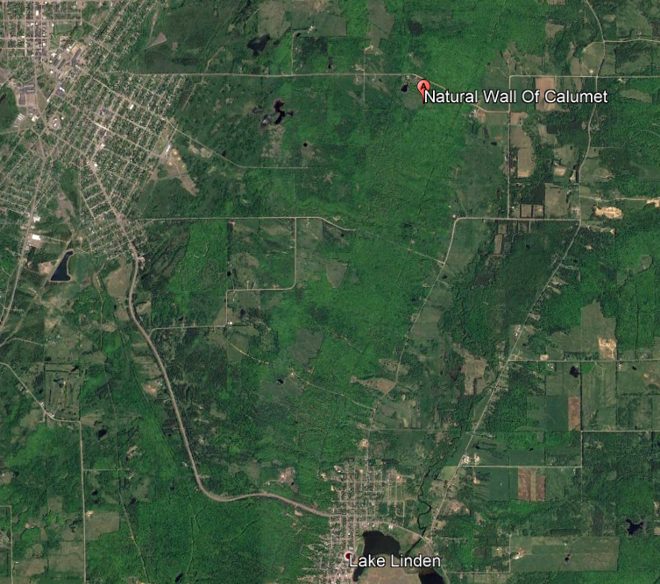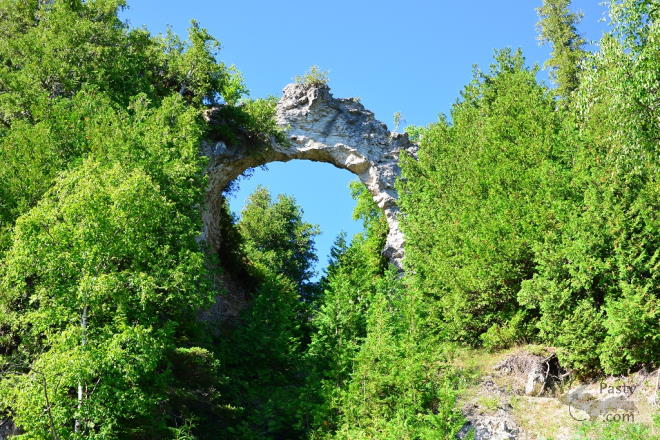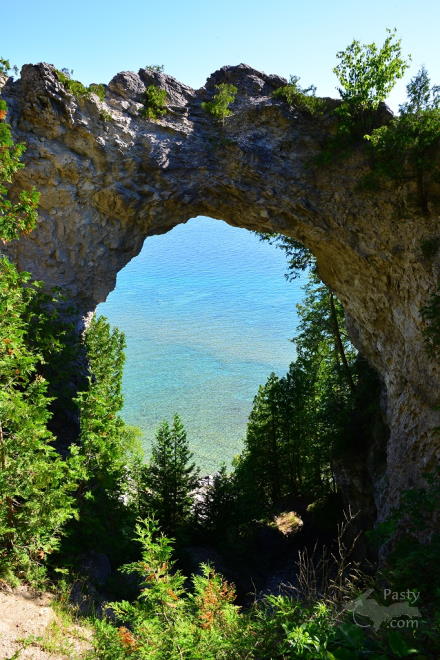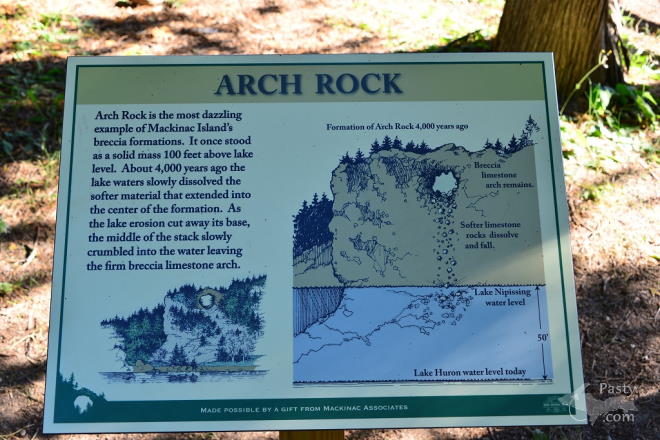By jbuck (Jbuck) on Sunday, September 6, 2020 - 08:39 pm:
Capt Paul did provide this info on the natural wall back in 2007:
By Capt. Paul (Eclogite) on Friday, February 9, 2007 - 11:03 am:
Hmmm, looks like we’ve been called out!! ;-) Since Dr. Nat is in class all day, I can give the low-down on Natural Wall. I apologize if this gets a bit long and I use some scientific jargon, but you can always ask me later…..
First and foremost, Natural Wall is not a dike. Dikes are tabular or sheet-like bodies of magma (i.e., igneous rock) that cut through and across the layering of adjacent rocks. They form when magma rises into an existing fracture, or creates a new crack by forcing its way through existing rock, and then solidifies. Once it solidifies, it’s not necessarily harder than the country rock. Natural Wall is made completely of Jacobsville Sandstone, and while it stands very near the Keweenaw Fault, there are very few basalts incorporated into the sandstone and none in the Wall. The photo NoTroll shows is a mafic basalt dike associated with the Crater Lake/Mt. Mazama region of Oregon. That is not to say that there aren’t any dikes in the UP. A dike swarm develops when the land is stretched to a point it thins and magma is allowed to come to the surface following fractures in the rock. One of these small swarms associated the Mid-continent Rift is south of L’Anse near Alberta, and other single dikes of this age can be seen along M-95 near Republic and in the Empire/Tilden Mine pits.
Now on the Wall itself. During the Mid-continent Rift stage as the land was being pulled apart (a modern day analog would be the East African Rift), normal faulting occurred along the edges of the rift. One of these major faults was the Keweenaw Fault, which runs the length of the peninsula. Towards the end of the rifting stage, sediments from the east and south (Jacobsville Sandstone) began to deposit along the southern edge of the basin that formed as a result of rifting. Next, a large continent sized chunk of crust began slamming into the east side of North America. This collision is known as the Grenville Orogen. During this event, compression on the Rift and Keweenaw Fault began changing the characteristics and movement of the Fault from being a normal to a high angle reverse fault. This compression also had a profound effect on the sandstone near the fault, tilting the once flat-lying beds of sandstone into vertical and even slightly backward. If one has the chance to walk the creek that flows beside the Wall, by all means do it!!! In about 1 km of walking the creek bed, you will go from flat to east dipping beds to vertical at the Wall. Of course as Mary said, you should obtain proper permission to enter and take a knowledgeable geo-person with you (hint hint ;-)
This is, of course, the Cliff Notes version of how Natural Wall came to be. I’m always open for more questions and a more in-depth look at the Wall, or any other geologic questions that may arise. I could yak about Lake Superior geology for hours; as you can probably tell, it’s one of the most fascinating areas on the planet, and that’s why I absolutely love studying it!!!
By D. A. (Midwested) on Monday, September 7, 2020 - 12:07 am:
Good job jbuck,
A walk up the creek seems like it would probably be an easier and smaller climb but also a much longer walk. The entry we made in order to get to the top of the wall, where my picture was taken was just 100 yards off Old Colony Road going east out of Laurium. At the time in 2016 it I believe it was still private property but our group had permission.
The GPS data is:
Lat: 47.241046°
Lon: -88.396377°

By jbuck (Jbuck) on Monday, September 7, 2020 - 08:47 am:
D. A. (Midwested),
I knew we had talked about the Natural Wall before - had to go find the discussion. As you say, hard to see it in the Summer. Karl Berg provided a Winter picture which Mary posted on that date which is excellent.
By Capt. Paul (Eclogite) on Monday, September 7, 2020 - 04:06 pm:
Did I actually write that? ;-)
Thanks to all of you who have enjoyed our little "Here we are..." geology snippets across the UP. Like Nat said, if we make it back up next summer, we will surely visit more spots across the UP and the northern lower as it too has some fascinating places. What we'd really like though is to meet some of you in person, once covid is controlled of course.
By jbuck (Jbuck) on Monday, September 7, 2020 - 05:34 pm:
Yes, yes, i think that was you Capt. Paul!
What's interesting is that back then when you explained that i as having a bit of trouble wrapping my head around it. Now after Dr. Nat's mini classes and other explanations over the years when i reread it now i think 'yes, that makes sense'!!!







